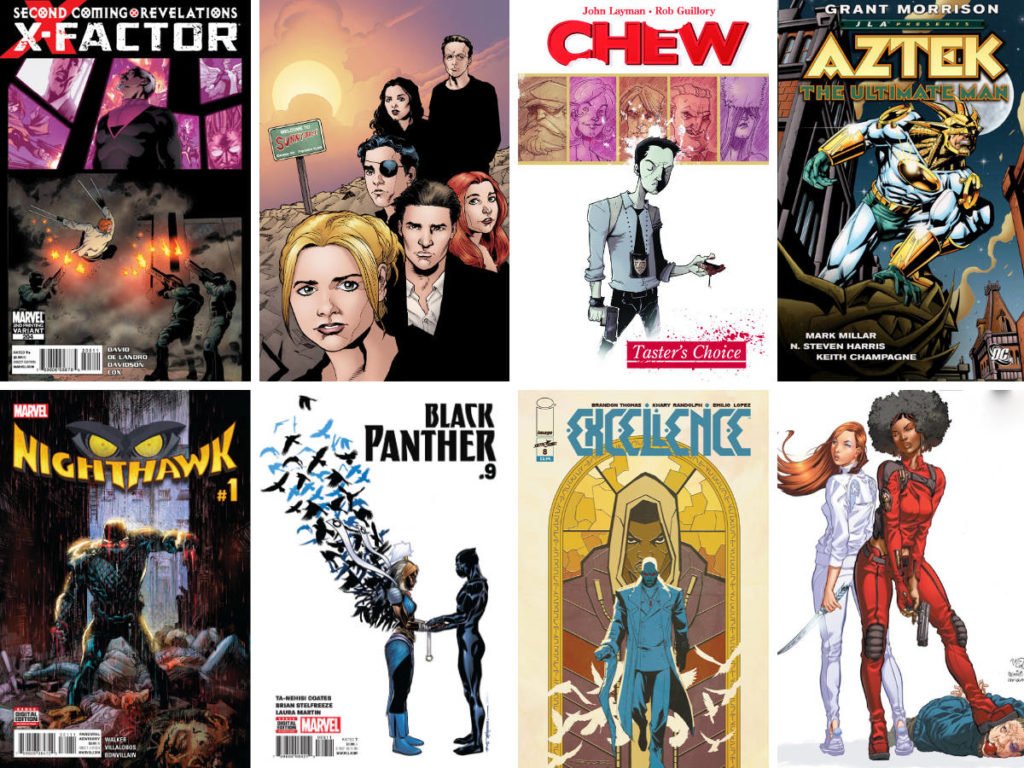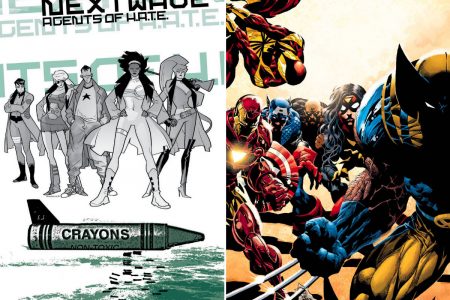This blog is not political, but the current state of the world means that talking about the entertainments I consume without mentioning it would seem ridiculous. Black Lives Matter. It’s that simple. Racism against people of colour and Black people in particular is wrong. The White Supremacist-in-Chief who currently leads the US and got to power through stoking racism is an abhorrent individual who should be removed from office. Yes, all lives matter, but not all lives are being murdered by the state for no reason – it is specifically Black people who are being killed by police officers who receive no punishment for their crimes. The USA has institutional racism that sees police brutally beating protestors who are Black but which allows white people armed with semi-automatic rifles to storm government buildings without trouble. (The UK has similar institutional racism – the scandal of the Windrush generation, the whole Brexit vote, the current suppression of reports on the effect of COVID-19 on BAME groups, and a lying, cowardly prime minster who described Commonwealth citizens as ‘piccaninnies’ with ‘watermelon smiles’ – but as yet we don’t have as many guns.)
Bearing this in mind and trying to adhere to the parameters of this blog, I thought I’d talk about the comic book work I’ve enjoyed from Black creators. The mainstream comic book industry has been (and still remains) a mostly white male place; there were occasional Black artists (the likes of Ron Wilson and Keith Pollard in the 1970s/1980s), but it took a while for that to change, so I wanted to discuss some of those Black creators and the work that has had an impact on my comic book reading over the decades.
The starting point for me is also a starting point for Marvel comics: Priest aka Christopher Priest formerly known as Jim Owsley, the first African American editor in mainstream comics at Marvel in 1979. I was unaware of the background and just responded to his writing when I discovered it in the 1990s – the first books I discovered were The Ray, Triumph and Justice League Task Force in the mid-90s, but it was 1997 when I became a full convert, with the trio of Steel, Xero and Quantum and Woody rocking my world (I would have letters published in Xero and Quantum and Woody, which made me so happy) in preparation for what I still think of as the definitive run on Black Panther in 1998 – his fractured storytelling, the humour, his vision of T’Challa as the man who was 10 steps ahead of everyone made for great comics books. Priest stepped away from comics for a decade, but he’s been back at it with runs on Deathstroke and Justice League at DC and is the current writer on Vampirella.
There were various artists associated with Priest’s work to point out: Mark ‘MD’ Bright’s art on Quantum and Woody (which he co-created with Priest) was an absolute delight – he’d worked with Priest before on Green Lantern, and pencilled the Iron Man Armor Wars storyline; ChrisCross was the artist for the majority of Xero, his style perfectly suited to the book, and who would pencil Priest’s Solar: Man of the Atom as well as Peter David’s Captain Marvel run in the early 2000s; however, the main name to highlight would be Denys Cowan – although he drew Priest’s run on Steel, he had come to prominence with his excellent pencils in The Question written by Dennis O’Neil in the late 1980s, which was a great series. Cowan would go on to draw a range of comic books (including the wonderfully odd Prince comic book with Dwayne McDuffie, Prince: Alter Ego), but would also become one of the co-founders of Milestone Media, where he co-created many of the lead characters (Priest was involved and going to be editor-in-chief but had to leave before launch due to personal reasons). This led to him becoming a producer on the Static Shock animated series and Senior Vice President of Animation at BET. Luckily for us, because his art is so good, Cowan still draws comic books, currently illustrating a Question mini-series written by Jeff Lemire.
Trying to stick to some sort of chronology, I should mention an artist whose work was a significant part of my comic book history: Malcolm Jones III. He had inked some of Cowan’s art on The Question in the late 1980s, but it would be his contribution to inking The Sandman between 1989 and 1991 that cements his position in the firmament. Another artist who opened my eyes was Larry Stroman on Peter David’s X-Factor run starting in 1991; I hadn’t seen Stroman’s work on Alien Legion before this, which made his debut on this title even more dazzling, with his exaggerated anatomy and high levels of individuality helping to make the book stand out in a crowded marketplace.
I probably first saw Kyle Baker’s inks in issues of The New Mutants in the late 1980s and his pencils on an issue of Classic X-Men, but it wouldn’t be until the mid-1990s that he became a creator whose work I sought. I bought Instant Piano, an anthology humour mini-series from Dark Horse that also included Evan Dorkin, mostly due to the regular posters on the rec.arts.comics.misc forums – the amount of people who would go on about The Cowboy Wally Show and quote hilarious bits from it was impressive and maddening because you couldn’t get your hands on a copy at the time. Fortunately, it was brought back into print and I could see that the hype was justified – the book is fantastically funny – and I would always try to get my hands on his work (another personal favourite of mine is Why I Hate Saturn). Baker is a deserving winner of many Eisner and Harvey awards.

There were various artists who illustrated the stories that I read. Ken Lashley drew various issues of Warren Ellis’ run on Excalibur. Ryan Benjamin drew just about everything at Wildstorm, including a few issues of WildCATS written by Alan Moore. Aztek the Ultimate Man, written by Grant Morrison and Mark Millar, was perfectly illustrated by N Steven Harris (who is currently drawing Michael Cray, written by Bryan Hill, with covers by Cowan). Greg Rucka’s first run on Detective Comics in 2000 had various artists, but my favourite was Shawn Martinbrough’s moody noir art, which perfectly encapsulated the right vibe for Gotham; he’s recently drawn Robert Kirkman’s Thief of Thieves, where his pencils were the perfect choice for the material.
The French artist Olivier Coipel brought his European sensibility to the Legion of Super-Heroes but he really burst on the scene drawing House of M in 2005, the crossover series that changed the status quo for Marvel’s mutants for a while. He recently drew Mark Millar’s The Magic Order, but he tends to do a lot of cover work. It was big geek news when it was announced that Buffy the Vampire Slayer would be canonically continued in the pages of a comic book led by Joss Whedon in 2007, so there would be a lot of attention on the art; but Georges Jeanty drew excellent likenesses of the actors and good storytelling, which is always a tough job. The series itself was uneven as Whedon got lost in what could be done in a comic book instead of a live-action television show, but Jeanty’s art didn’t falter. I first saw Valentine De Landro’s art on the second volume of X-Factor written by Peter David in the late 2000s; it was a little raw but good and constantly developing, so it was good to see him make his name on Bitch Planet, the Image series co-created with Kelly Sue DeConnick, which plays with exploitation riffs but has a larger point.
I had never seen Rob Guillory’s art in 2008 before reading Chew, co-created with John Layman, but I was instantly a fan of his quirky, cartoony, funky art style that perfectly captured the wonderfully bizarre tone of the book, which had a lead character who could sense memories of the food he ate in a world where the FDA was the most powerful government body and chicken was illegal. I’m looking forward to tracking down his own creator-owned series, Farmhand. Another artist whose style I have always enjoyed is Brian Stelfreeze, but he doesn’t have a run on a series to specifically point out from my past – I was aware of his art from the early 1990s with his 50-issue run of covers for Batman: Shadow of the Bat, but he seemed to do an issue here and there of various books. I have a copy of The Ride somewhere in my collection, and I’ve read the first collection of Day Men from Boom! Studios that he drew, but the largest project he’s worked on that I’ve enjoyed has been his art for the Ta-Nehisi Coates successful relaunch of Black Panther, a very interesting series that took a very different approach to the character than Priest’s take. The success of this Black Panther has led to various spin-offs, some more successful than others, and has allowed for other Black creators to be part of the series, including Roxane Gay and Nnedi Okarofor. Gay worked on the World of Wakanda series (with some lovely covers from Afua Richardson) and Okarofor was given the Shuri spin-off (and you should read Okarofor’s Africanfuturism sci-fi novels if you can – I highly recommend Binti). In addition to Black Panther, Coates has been writing an interesting run on Captain America, examining what the character means in today’s world.
There are many black artists whose work I have enjoyed (Doug Braithwaite, Keron Grant, Jimmie Robinson, Khari Evans, Khary Randolph, the inking of Dexter Vines), but I tend to focus on writers more. I have only read a few things by the late Dwayne McDuffie but it was enough to know that his was a talent taken too soon. I have recently read books by David Walker – it started out with his Nighthawk, which really captured the spirit of the character, and then his interesting work on Occupy Avengers and his Power Man and Iron Fist with the wonderfully off-beat art of Sanford Greene, which I’d first seen on the Secret Wars Runaways series. I’ve also read Naomi, co-written with Brian Michael Bendis and beautifully illustrated by Jamal Campbell, all of which suggest that Bitter Root, his co-creator-owned series at Image, which will be an intriguing read when I can get my hands on it.
As you can see from my selection, it tends towards the mainstream industry but still includes a lot of Black creators; there are even more outside of that area which I haven’t been able to mention because I haven’t sampled them yet. I hope that this has given you a taste of what’s available.




